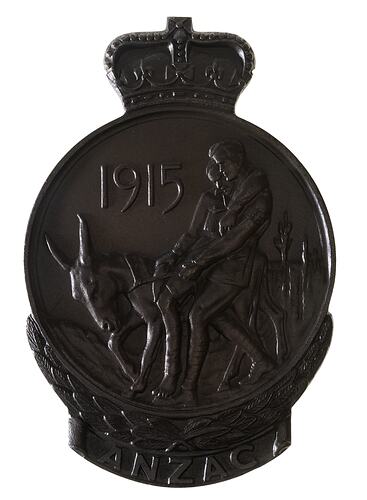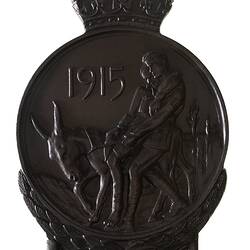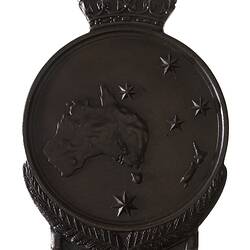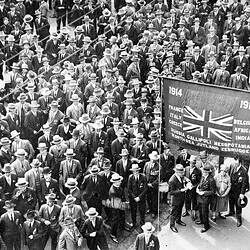Summary
Anzac commemorative medallion awarded to W. Kennedy in 1967 to mark the 50th anniversary of Gallipoli.
These medals were issued by the Australian government in 1967 to commemorate the 50th anniversary of the Gallipoli landings. Designed by former war artist and Australian War Memorial sculptor Raymond Ewers, they were issued to surviving veterans or their next of kin. All members of the Australian Defence Force who served during the Gallipoli Campaign were entitled to receive the award.
The Gallipoli campaign lasted from April 25 1915 to January 8 1916. The award was made for service on the Gallipoli Peninsula and in support of the operations in an area off-shore eastward of a line drawn from Yukyeri Point (lat 39 50' 40'' N long 26 9' 45'' E) through a point in lat 39 53' N long 26 0' E thence to Cape Gremea (lat 40 35' N long 26 6' E). The award was also made available to members of philanthropic organisations and the Press who were accredited to the AIF, and to Australian members of the crews of merchant ships or hospital ships which operated in direct support within the defined area.
Physical Description
Circular bronze medal with crown atop.
Obverse Description
Based on a circular bronze medal but surmounted by the Queen's crown and supported above a wreath and scroll bearing the word ANZAC, the obverse features Simpson and his donkey assisting a wounded man to left, with the date 1915 in the field above.
Reverse Description
A relief map of Australia and New Zealand with the Southern Cross around it, below, a wreath of fern fronds and a ribbon engraved with name of the recipient, W. KENNEDY.
Edge Description
Plain
Significance
Statement of Significace:
The Anzac commemorative medallion and badge were issued in 1965 to survivors and next of kin to commemorate 50th anniversary of landings on Gallipoli. It took two years for the medals to be awarded.
Statement by the Prime Minister, the Rt. Hon. Harold Holt, in the House of Representatives, 16 March 1967:
'Last March, the Minister for Defence announced that it had been decided by the Australian Government, in consultation with the New Zealand Government, to issue a medallion and lapel badge to the veterans of the Gallipoli Campaign.
'I am glad to be able to announce that arrangements have now been completed for the production of the medallion and the badge. The Minister for the Army will be arranging distribution to those wishing to receive them as soon as possible.
'The Government hopes that production of the medallion and lapel badge will be sufficiently advanced to permit at least some of them to be distributed by Anzac Day.
'The medallion (with the name of the recipient inscribed) will be issued to the surviving members of the Australian Defence Force who served on the Gallipoli Peninsula, or in direct support of the operations from close off-shore, at any time during the period from the first Anzac Day in April, 1915 to the date of final evacuation in January, 1916. Next of kin or other entitled persons will be entitled to receive the medallion on behalf of their relatives, if the relative died on active service or has since died.
'For surviving members, a lapel badge will also be available for wearing. This will be a replica of the obverse (or front) of the medallion and will be about 1 inch high and 2/3 inch wide - the same size as the RSL badge.
'The medallion is the work of Mr. Raymond Ewers, the well-known Australian artist, based on a suggestion by Mr. Eric Garrett, a staff artist with the Department of the Army. It has been endorsed by both the Government of New Zealand and ourselves. It will be approximately 3 inches high and 2 inches wide. The obverse of the medallion depicts Simpson and his donkey carrying a wounded soldier to safety. It will be bordered on the lower half by a laurel wreath above the word ANZAC. The reverse shows a relief map of Australian and New Zealand superimposed by the Southern Cross. The lower half will be bordered by New Zealand fern leaves.
'The medallion will be cast in bronze and the lapel badge will be metal of a bronze colour.
'For the information of the honourable members I present also a brief statement setting out the conditions of eligibility which will apply to the medallion and badge and the manner in which those desiring to receive them should apply.'
All members of the Australian Defence Force who served during the Gallipoli Campaign were entitled to receive the Anzac Commemorative medallion. The Gallipoli campaign lasted from April 25 1915 to January 8 1916. The award was made for service on the Gallipoli Peninsula and in support of the operations in an area off-shore eastward of a line drawn from Yukyeri Point (lat 39 50' 40'' N long 26 9' 45'' E) through a point in lat 39 53' N long 26 0' E thence to Cape Gremea (lat 40 35' N long 26 6' E). The award was also made available to members of philanthropic organisations and the Press who were accredited to the AIF, and to Australian members of the crews of merchant ships or hospital ships which operated in direct support within the defined area.
More Information
-
Collecting Areas
-
Date Issued
1967 AD
-
Issued By
Australia, 1967
Issued to survivors and next of kin to commemorate 50th anniversary of landings on Gallipoli. This occured in 1965 but it took two years to get the medals awarded. -
Artist
-
Awarded To
-
Place
Gallipoli Peninsula, Turkey, 1915
Place medal recepient served -
Inscriptions
ANZAC 1915
-
Series
-
Material
Bronze
-
Axis
12
-
Classification
-
Category
-
Discipline
-
Type of item
-
Dimensions
50 (Width), 75 (Height)
Weight > 100 g.
-
Shape
Round with crown at top
-
References
Car. 1915/3 Australian War Memorial website [Link 1] -D. Tout-Smith 21/10/2003.
-
Keywords
Anzac Day, Commemorations, Wars & Conflicts, World War I, 1914-1918



